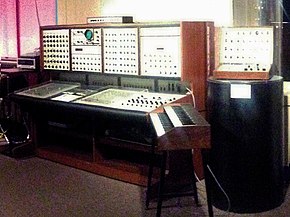

The EMS Synthi 100 was a large analogue/digital hybrid synthesizer made by Electronic Music Studios, London, originally as a custom order from Radio Belgrade for what was to be the Radio Belgrade Electronic Studio, largely thanks to contact between composer Paul Pignon, then living in Belgrade, and Peter Zinovieff. The synthesiser was designed by David Cockerell and documented in detail in 1971. The cost at that time was £6,500 (about £92,500 in 2020 Pounds).[1] The last unit built by EMS was number 30.[2] Afterwards, one final unit was built by Datanomics, who bought assets from EMS when the company folded in 1979.[3] The redesigned unit was sold to Gabinete de Música Electroacústica, Cuenca, Spain.[4]
Developed from an initial concept of three VCS3 systems, the analogue modules on their own more closely resemble six VCS3s. With the addition of the 256-step digital sequencer's circuit cards, the card count rises to 85 (28 times larger than a VCS3 by circuit board count), with 12 voltage-controlled oscillators and eight voltage-controlled filters Two monophonic keyboards (both keyboards together produce four control voltages and two key triggers simultaneously). The digital sequencer has three (duophonic) layers, 10,000 clock events and 256 duophonic note events. Two 60 × 60 matrixes were used to connect the different modules by using patch pins. The keyboard spread could be adjusted, making it easy to play a tuned equal temperament scale as well as alternative microtonal tunings up to 61 divisions of each semitone.
The Synthi-100 was developed a few years after the first VCS3s. Both filters and oscillators were much more stable in the Synthi-100. There is an oscillator sync function that can sync the 12 main oscillators to each another or from an external source.[5] The Synthi 100 also had an add-on computer interface known as "Computer Synthi" which contained a PDP-8 minicomputer and 4Kb of random access memory. It featured an LED display, twin digital cassettes, Two 24 × 60 matrix patchboards, and a switch button control panel. Only three were sold.[6] The Vocoder 5000 (Studio Vocoder) was available as a separate module installed into the Synthi 100. It contained a 22 band filter, 22 × 22 matrix patchboard, mic/line inputs, two oscillators and noise sources, frequency shifter, pitch to voltage extractor, and a spectrum display driver.[7]
- ^ Hinton, Graham. "A Guide to the EMS Product Range". Electronic Music Studios. Retrieved June 2, 2017.
- ^ The University of Melbourne (2015-09-23), Synthi 100, archived from the original on 2021-12-12, retrieved 2018-10-13
- ^ "The EMS History". emssynthesisers.co.uk. Retrieved 2019-05-08.
- ^ "Fuzzy Gab .4 » Gabinete de Música Electroacústica de Cuenca (GME). Ayer y Hoy" (in European Spanish). Retrieved 2019-05-08.
- ^ Pignon, Paul (2008). "The radio Belgrade electronic studio: Equipment, procedures, other information". Interface. 3 (2): 177–186. doi:10.1080/09298217408570195. ISSN 0303-3902.
For synchronization of the oscillators use White pins (2.7kΩ). 3.7.4.2 - The synchronization of an oscillator
- ^ Thom Holmes (2015-10-08). Electronic and Experimental Music: Technology, Music, and Culture. Routledge. pp. 277–. ISBN 978-1-317-41023-2.
- ^ Hinton, Graham. "A Guide to the EMS Product Range". Electronic Music Studios. Retrieved June 2, 2017.